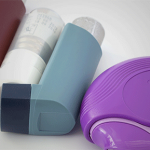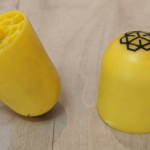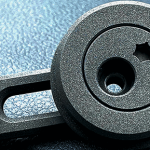- Home
- 3D Printing
- What is Selective Laser Sintering?
What is Selective Laser Sintering?
Selective Laser Sintering, more commonly known as SLS, is one of the most popular technologies for 3D printing. We have three SLS 3D printers that are kept busy building prototype and end-use parts. In this article, we take a detailed look at SLS technology, the material properties of SLS parts, advantages compared with other 3D printing technologies, and some typical applications.
A brief history of SLS
SLS was developed, and patents were granted, in the mid-1980s. The technology started as an academic research project at the University of Texas at Austin, USA, sponsored by DARPA (the USA Defense Advanced Research Projects Agency). Its commercial potential was quickly recognised, leading to the establishment of DTM for manufacturing and marketing SLS 3D printers. 3D Systems acquired DTM in 2001.
SLS 3D printing technology
The basic concept underlying SLS is that a high-powered laser traces a path on the surface of a bed of fine plastic powder. The heat from the laser fuses particles to adjacent particles and also those just beneath them. Once the laser has traced the entire layer (or slice) of the part, the powder bed descends by an amount equal to the layer thickness. Fresh powder is then spread across the top and the laser fuses the next layer. This process continues until the complete part has been 3D printed.
Almost any three-dimensional form can be built with SLS, including hollow features and overhangs. As the part is built, it is supported by the surrounding unfused powder. Consequently, unlike some other 3D printing technologies, there is no need for support structures that consume material and have to be removed from the built part.
Because the technology utilises a costly and potentially hazardous high-powered laser, it tends to be used commercially and not by home users or hobbyists. Furthermore, care has to be exercised when storing and handling the fine powder, and when cleaning the 3D-printed parts.
Workflow – from CAD data to physical part
Assuming the part has been designed using a solid modelling CAD system, the designer will send us a step file or upload it via our website form so we can review the data and prepare a quote. We do not require 2D drawings unless particular information needs to be communicated – such as threads or critical tolerances.
A member of our 3D printing team then checks the model and this is the point at which we will raise any queries with the customer and discuss concession. These might be with a view to improving the part accuracy or surface finish – or reducing costs for the customer.
Once the model file is ready, the CAD data is converted into a format suitable for downloading to the SLS 3D printer. We normally nest multiple parts for building simultaneously, so we can maximise the efficiency of the 3D printing process.
Printed parts need to cool before they are removed from the machine. Unfused powder is removed by hand at first then the parts are put through two separate air blasting systems; the first removes powder that could not be removed by hand, and the second blasts the parts with very fine glass beads to smooth the surface, removing the slightly rough surface texture that SLS parts are known for.
SLS finishing and assembly options
By this point the part might be ready to use or, if requested, we can perform additional finishing operations. One popular option is a coat of clear lacquer to seal the surface, another is polishing, or the part can be sanded, primed and painted. A further finishing option unique to SLS parts is SLS dyeing, most commonly in black but almost any colour may be specified, including RAL and Pantone shades. If requested, a coat of clear lacquer can be applied on top of the dyed finish.
Functional parts can benefit from a blackout/RFI/EMC coating applied to internal ‘B’ surfaces.
Customers often request assembly operations for SLS parts. This might entail assembling the part with other 3D printed parts made by SLS or alternative technologies, as well as CNC machined parts, standard off-the-shelf components, or proprietary or prototype parts supplied by the customer.
When the part has been finished or assembled with other parts, it is packaged ready for dispatch.
Dispatch options for SLS part
Depending on the level of finishing required, we offer SLS parts with Express, Standard or Economy Delivery. Express parts are shipped the next working day, whereas parts ordered with Standard Delivery are shipped in three working days and Economy parts in eight working days.
Despite the longer lead time, Economy parts are 3D printed and finished to the same high standard; this delivery option simply offers a lower-cost option for customers constrained by tight budgets.
Material properties
We use PA2200 Nylon in our SLS 3D printers. This is a high-specification, versatile white material that has polyamide 12 (PA12) as its base. Parts built from PA2200 benefit from high strength and stiffness, long-term dimensional stability, abrasion resistance, chemical resistance and biocompatibility (EN ISO 10993-1 and USP Class VI).
The mechanical properties make PA2200 suitable for functional prototypes and end-use parts, with the abrasion resistance being beneficial for mechanisms, and UV tolerance preventing parts from degrading in sunlight. Snap fits can be successfully 3D printed in PA2200.
Care has to be taken when selecting the build orientation, as the sintered material is not isotropic, with strength and stiffness being marginally superior in the X and Y axes.
As you would expect, at elevated temperatures, PA2200 SLS 3D printed parts behave in a similar way to those injection moulded in nylon. However, be aware that the laser processing can result in residual stresses that sometimes cause warpage or distortion when temperatures rise during use.
Advantages of SLS compared with other 3D printing technologies
Thanks to the lower cost of equipment and material compared with some other 3D printing technologies, SLS is often a lower-cost option. Despite this, parts are still accurate and can feature complex geometry and fine details. At the same time, the surface finish is good and parts have high strength and stiffness.
PA2200 is UV-stable and parts have good long-term dimensional stability and weather resistance. Abrasion resistance and coefficient of friction are also better than for many other 3D printing materials, so SLS parts are good for mechanisms or assemblies where components move relative to each other.
In contrast to many other 3D printing technologies, SLS parts do not require support structures during the build process. Consequently, there are no support structures or witness marks to remove. Also, it is straightforward to 3D print ready-assembled parts, such as chains and hinges, which is not always possible with other 3D printing technologies.
Design tips for SLS 3D printing
SLS is often used for prototyping parts that will ultimately be manufactured by injection moulding. Generally speaking, if a part can be injection moulded, it can be 3D printed by SLS.
However, when end-use parts are being produced with SLS, it becomes feasible to incorporate features that cannot be injection moulded or would be very expensive. These include complex internal voids, lattice structures, negative draught angles and hollow spaces. The designer simply needs to ensure unsintered powder can be removed by, for example, incorporating escape holes of adequate size.
Another possibility is 3D printing ready-assembled parts. Sufficient clearance needs to be designed-in to allow unsintered powder to be removed from between the parts – so don’t expect to create high-precision mechanisms this way – but it can be a very useful technique for some assemblies.
Alphanumeric text and logos can be 3D printed with SLS. It is even possible to build batches of parts with each having a unique ID printed on the surface. Such features can be engraved or raised, depending on factors such as size and finishing operations.
Relatively large parts can be 3D printed with SLS but we advise against extensive flat surfaces or long slender features, as these can distort due to thermal effects (remember that the powder is heated during the build process, and the laser raises the temperature locally as it sinters the powder).
Large internal and external threads can be 3D printed but if parts are to be assembled using screws, we recommend installing threaded inserts instead of relying on 3D-printed female threads or using self-tapping screws in plain holes.
Living hinges can be 3D printed but they do not perform in the same way as their injection moulded counterparts. If a living hinge is required, it is best to redesign it to lengthen the flexing element and reduce the strain. Also, the material will need to be annealed in hot water before flexing the hinge. Alternatively, the living hinge can be replaced with a ready-assembled mechanical hinge that does not stress the material.
Our SLS experts are always happy to discuss design details such as wall thicknesses, hole sizes, tolerances and text/graphics, so call us if you have any queries.
Applications for SLS 3D printed parts
SLS is a very versatile 3D printing process and is suitable for almost every stage of the product development process, from concept models to functional prototypes, presentation models, end-use parts, and assembly jigs and fixtures.
The versatility also means SLS is used by customers from a wide range of industries including medical devices, consumer goods, electronics, automotive, aerospace, special-purpose machinery and factory automation.
Whether you need a one-off prototype part or small batches of end-use parts, SLS can be quick and cost-effective. Bear in mind that we only use PA2200 material, so you would need to check that the material properties are appropriate for your application.
Talk to us
If you need SLS 3D printed prototype or end-use parts, talk to our experts on 01763 249760, or complete the enquiry form below to request a quote.





